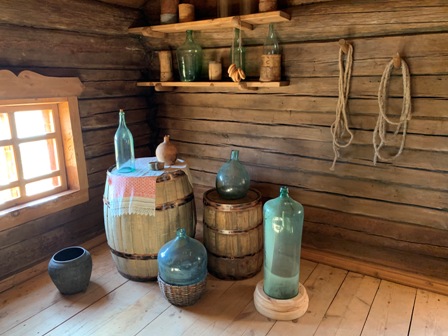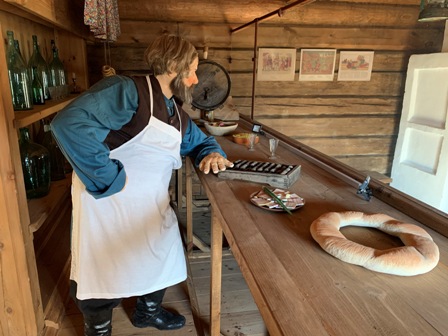Кабак
|
|
 |
Существование многочисленных питейных заведений было распространённым явлением в населённых пунктах, расположенных по Московскому тракту. К настоящему времени зданий сельских кабаков в регионе не сохранилось. Так как планировка кабаков была схожа с планировкой торговых лавок, экспозиция разместилась в доме-лавке конца XIX в. из села Тулюшка Куйтунского района.
Строение представляет собой дом-крестовик, состоящий из торгового (вход с улицы) и жилого (вход со двора) помещений. Жилая часть отражает традиционный крестьянский интерьер, своеобразием помещения является восстановленная оригинальная роспись стен и потолка.
Торговую половину дома занимает кабак с подсобным помещением. В кабаке реконструированы печь-голландка, прилавок, полки для складирования стеклянной тары и скамьи для посетителей. За прилавком посетителей встречает ростовая фигура владельца кабака.
По данным
Восстановленная в музее усадьба традиционно имеет два двора — чистый и хозяйственный. Дворы разделены между собой навесом с расположенными под ним зимовьём, стайкой для свиней и калиткой, ведущей на хозяйственный двор. Линию построек замыкает однокамерный амбар.
TAVERN
The museum exposition is set in a house of the late 19th century, which was relocated from the village of Tulyushka in the Kuitunsky district of the Irkutsk region. The building was occupied by a local trading shop at the beginning of the 20th century. Since there were no old taverns left in the region, and the layout of the retail premises was similar to the layout of a tavern, they decided to repurpose the place for display. The restoration of the tavern was completed in 2010.
The tavern is a cross-shaped building, a compound of commercial and residential premises with separate entrances from the street and the back of the house. The living room displays a traditional peasant interior, with restored original paintings on the walls and ceiling that creates a special atmosphere. The commercial part of the house is occupied by a tavern with a utility room. Tiled stove, a counter, shelves for glass containers storage and benches for visitors have been reconstructed in the tavern. Behind the counter, there is a full-length figure of a tselovalnik (a bar-tender).
Tavern’s predecessor was“korchma” (a dive), where people gathered for drinking, eating and entertaining with songs and music. "Tsarev's pubs" in Russia emerged in the 16th century, the time of Ivan the Terrible, who introduced a royal monopoly on the production and sale of alcohol: bread wine (vodka), honey, beer. Starting from the middle of the 18th-century pubs began to sell alcohol on tap and to go, which spread throughout the state including Siberia. Fraud and bribery were flourishing in the taverns. Tselovalnik is were not shy to dilute vodka with water. Alcohol was sold at night for the guards who bribed the bartender. It was sold on credit. Tobacco and gambling were also present in taverns. Most of the pubs turned into rookeries where people were getting drunk and robbed.
In 1887, the number of drinking houses (taverns) in the Baikal Region reached 607. Eastern Siberia ranked first in the Russian Empire in terms of alcohol consumption in 1893: the number of vodka consumed per capita equalled 0.7 buckets (in Western Siberia the consumption yielded 0.35 buckets).
酒馆
博物馆博览会位于19世纪末一所房屋中。 这座住宅是从伊尔库茨克州奎通斯基区图卢什卡镇。二十世纪初房子里有一家农民商铺。由于该地区的乡村小酒馆的建筑没有保存下来,安排像乡村饮酒场所,因此酒馆展品放置这个住宅里。该对象的恢复在2010年完成。
该建筑是五面承重墙结构平房,由商房和住房组成,从街道和院子进入的入口各不同。客厅反映了传统的农民室内装饰,其独创性的墙壁和天花板的绘画。商房屋有小酒馆和附属用房。小酒馆中重建了一个荷兰 炉,一个柜台,用于存放玻璃器的架子和客人使用的长凳。售货员的全长雕像被放在柜台后面。
小酒馆出现之前每个居民点有 科尔奇马 (革命前白俄罗斯的小酒店),人们聚集在那里品尝食物,喝酒,交谈, 唱歌,听音乐。自16世纪以来,俄罗斯出现了“沙皇的酒馆”,伊凡雷帝时期就建立了沙皇垄断的生产和销售酒精-面包酒 (伏特加),蜂蜜,啤酒。从18世纪中叶起小酒馆开始根据赎金制度工作。酒馆里面会喝酒,也会外卖。酒馆里诈欺罪也受贿罪。酒馆的售货员加水把伏特加冲淡些,受贿夜间卖酒精,并在酒馆出售烟草,里面也会赌博。大多数小酒馆都变成了赌窝,人们在那里喝醉,也会被抢劫。
1887年,贝加尔湖地区的酒馆(酒馆)数量达到607家。1893年,西伯利亚东部地区占俄罗斯帝国中排名第一:人均伏特加酒醉酒的数量为0.7桶(西伯利亚西部地区为数字是0,35个桶)。
Заявка успешно отправлена!
Укажите свои данные
мы ответим на ваш вопрос









